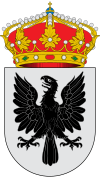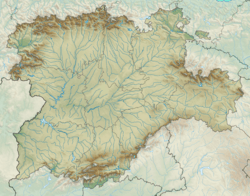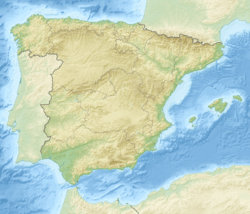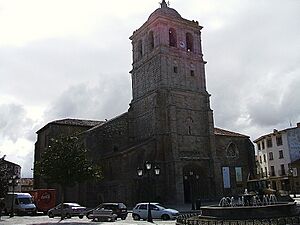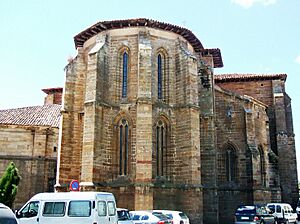Aguilar de Campoo facts for kids
Quick facts for kids
Aguilar de Campoo
|
||
|---|---|---|
 |
||
|
||
| Country | Spain | |
| Autonomous community | Castile and León | |
| Province | Palencia | |
| Area | ||
| • Total | 30.62 km2 (11.82 sq mi) | |
| Elevation | 892 m (2,927 ft) | |
| Population
(2018)
|
||
| • Total | 6,842 | |
| • Density | 223.45/km2 (578.73/sq mi) | |
| Demonym(s) | Aguilarenses | |
| Time zone | UTC+1 (CET) | |
| • Summer (DST) | UTC+2 (CEST) | |
| Postal code |
34800
|
|
Aguilar de Campoo is a town and municipality in northern Spain. It's located in the province of Palencia, within the Castile and León region. The River Pisuerga flows right through the middle of this historic town. In 2011, about 7,741 people lived here.
Aguilar de Campoo is an important stop on the St. James' Northern Way, a famous pilgrimage route. Since 2017, the town has been part of the Las Loras Geopark. This is the first UNESCO Geopark in the Castile and León region, recognized for its special geological features.
Contents
Discovering Aguilar de Campoo's Past
Early History and Royal Status
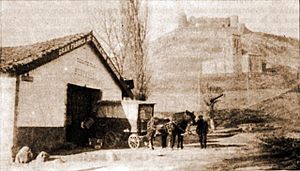
In May 1255, King Alfonso X the Wise gave Aguilar de Campoo a special royal charter, called a fuero. This meant the town became a realengo, which was land directly owned by the king. This royal status lasted until 1332.
A Community of Many Cultures
During the Middle Ages, Aguilar de Campoo was home to a notable Jewish community. The first records of Jewish people living here date back to 1187. After the 1492 expulsion of the Jews from Spain, the community became much smaller. You can still find an inscription in Judeo-Castilian (Spanish written with Hebrew letters) on the Reinosa Gate, one of the city's old gates. It tells who built the gate.
The Rise of Biscuit Making
In the early 20th century, Aguilar de Campoo became famous for making biscuits. Two important biscuit factories, Gullón and Fontaneda, opened here in 1904 and 1913. This helped the town become a well-known center for biscuit production in Spain.
Exploring Main Sights
Religious Buildings to See
- Monastery of Santa María la Real: This beautiful monastery was built between the 11th and 13th centuries.
- Collegiate Church of San Miguel: This church shows different building styles from the 11th to the 16th centuries.
- Church of Olleros de Pisuerga: An ancient church dating back to the 7th to 9th centuries.
- Hermitage of Santa Cecilia: A charming hermitage from the 12th century.
- Church of San Andrés: Another historic church built in the 12th century.
- Monastery of Santa Clara: This monastery was founded in 1430.
Important Civil Architecture
- Medieval castle: Explore the ruins of the old castle.
- Major Square: The main square where many important buildings are located.
- Palace of the Manrique (Marquess of Aguilar de Campoo): A grand old palace.
- Palace of the Villalobos-Solorzano: Another historic palace in the town.
- Palace of the Marquises of Villatorre: A palace belonging to the Marquises of Villatorre.
- House of the Priest: A historic house.
- House of Santa Mª La Real: A house connected to the Santa María la Real monastery.
- House of the Marcos Gutierrez: Another notable old house.
- House of the Seven Linajes (lineages): A house representing seven important family lines.
- House of the Velardes: A historic house belonging to the Velardes family.
- Medieval walls and gates: Discover parts of the old town walls and its gates.
Bridges of Aguilar de Campoo
The town has several historic bridges crossing the River Pisuerga and other waterways:
- Major Bridge
- Bridge of Portazgo
- Bridge of Turruntero Mill
- Bridge of la Teja
- Bridges of Paseo de la Cascajera
- Bridges of Tenerias
Local Industry
Aguilar de Campoo is well-known for its biscuit industry. It is home to the Galletas Gullón factory. This factory is the largest maker of biscuits in Spain and one of the biggest in all of Europe.
See also
 In Spanish: Aguilar de Campoo para niños
In Spanish: Aguilar de Campoo para niños


